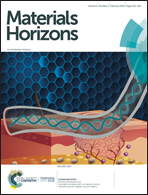A general strategy of 3D printing thermosets for diverse applications†
Abstract
Three-dimensional (3D) printing offers great potential to customize sophisticated constructs for a myriad of applications. However, many thermosets require long-term curing under harsh conditions, which is not compatible with rapid 3D printing processing. 3D printing of these thermosets remains a challenge. Here, we report a new strategy for direct 3D printing of various thermosets via readily available extrusion-based technology using sacrificial sodium chloride particles as a removable thickener for printing and a reinforcer for curing, exemplified by crosslinked polyester, polyurethane and epoxy resins. Specifically, the 3D constructs exhibited hierarchical and porous architectures, which are highly desired for many applications, including regenerative medicine, sensors, actuators, catalyst supports, and energy absorbers. As a proof-of-concept demonstration, we 3D printed vapomechanical sensors and actuators featuring fast, large, robust, and gradient responsiveness, in addition to biodegradable scaffolds to promote vascularization and tissue ingrowth in vivo and elastic myocardial patches to efficiently treat myocardial infarction. We expect that this study will pave a new way to tailor sophisticated 3D structures of thermosets and will be very useful for diverse applications.



 Please wait while we load your content...
Please wait while we load your content...